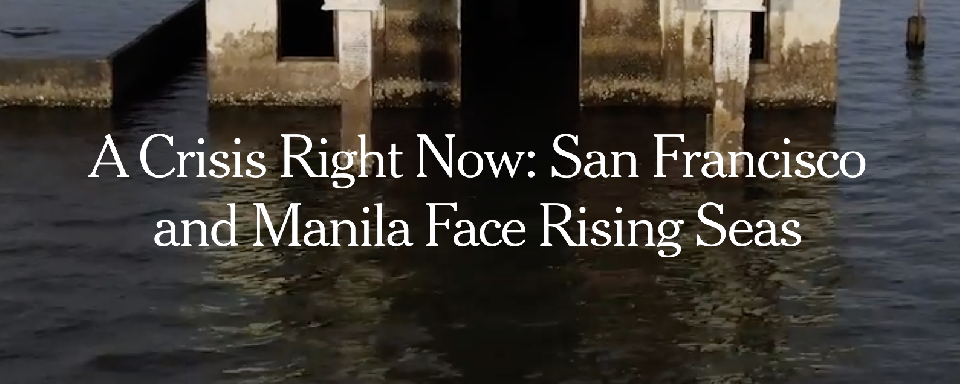A Crisis Right Now: San Francisco and Manila Face Rising Seas
nytimes.com

What do you do when the sea comes for your home, your school, your church?
You could try to hold back the water. Or you could raise your house. Or you could just leave.
An estimated 600 million people live directly on the world’s coastlines, among the most hazardous places to be in the era of climate change. According to scientific projections, the oceans stand to rise by one to four feet by the end of the century, with projections of more ferocious storms and higher tides that could upend the lives of entire communities.
Many people face the risks right now. Two sprawling metropolitan areas offer a glimpse of the future. One rich, one poor, they sit on opposite sides of the Pacific Ocean: the San Francisco Bay Area (population 7 million) and metropolitan Manila (almost 14 million).
Their history, their wealth, and the political and personal choices they make today will shape how they fare as the water inevitably comes to their doorsteps.

In both places, it turns out, how you face the rising sea depends mostly on the accident of your birth: Whether you were born rich or poor, in a wealthy country or a struggling one, whether you have insurance or not, whether your property is worth millions or is little more than a tin roof.
And, in both places, climate change has magnified years of short-sighted decisions. Manila allowed groundwater to be pumped out so fast that the land sagged and turned into a bowl just as the sea was rising. The Bay Area allowed people to build right at the water’s edge, putting homes, highways, even airports at risk of catastrophic flooding.
But people tend to hold on, often ingeniously, as the water rises around them. In some cases that’s because their properties are worth a lot, for now, at least, or because they have so little that they have nowhere else to go.
Now, Manila and the Bay Area face tough choices. They could adapt to the rising tide, which could mean moving people out of harm’s way. Or, they could try to force the water to adapt to their needs by raising their defenses. For leaders, politically tough decisions lie ahead. What do they save on the water’s edge, what do they forsake and how do they reimagine their coastal cities in an age of climate disruptions?
The Bay Area and Metropolitan Manila are both big and growing, with a lot of people and things to protect on the coast. How they deal with their circumstances today may offer lessons, for better or worse, for coastal cities elsewhere.
“Are we going to decide by not deciding, and wait for the water to reach our doorsteps?” asked Aaron Peskin, a member of the San Francisco board of supervisors.
“The biggest challenge is getting society to understand it, grapple with it, address it, plan for it, discuss the trade-offs.”
Desiree Alay-ay is in the thick of trade-offs.
Ms. Alay-ay, 30, grew up in a low-lying, flood-prone neighborhood on the northern fringe of Manila. It is not what she wants for her newborn baby. She wants to move, and take her parents with her.
Climate change has exacerbated a longtime problem in Manila. Because of a proliferation of fish ponds and the rapid extraction of groundwater, the ground has been subsiding. As a result, since the early 1990s, sea levels have risen by as much as 5 to 7 centimeters a year, or double the global average.
Storms repeatedly sweep away spindly-legged bamboo and tin houses on the water. People flee for a while, only to come back because they have nowhere better to go. In low-lying neighborhoods, like Ms. Alay-ay’s, roads have been raised multiple times. Pariahan, a village just north of the city line, is now permanently underwater.
“Climate change doesn’t create its own impacts. It magnifies wrong policies,” said Renato Redentor Constantino, executive director of the Manila-based Institute for Climate and Sustainable Cities. “This is the case with sea level rise. A large part of Metropolitan Manila is facing more water-related impacts because of decades of myopic, cross-eyed land use planning.”
More than 30 years ago, before Ms. Alay-ay was born, her parents, migrants from the countryside, built a small house in Malabon, the only neighborhood they could afford in Manila.
The water pooled up in the streets every rainy season. When they were kids, Desiree and her brother sneaked out and swam in the streets sometimes. Leaky sewers meant human waste sometimes floated by, which they referred to as “bazookas.” Only tricycle cabs could ply through floods; when the water rose, her parents took her to school in a rented boat.
The city fought back by raising the road. So, Desiree’s parents raised their house to stay above the road. They poured cement and sand on the floor, four times in 30 years, as though adding layers to a wedding cake.
Everyone lived like this. One neighbor raised the floor so high that the original kitchen sink is now ankle-high. Another abandoned the house altogether; its roof is barely above street level now, and water hyacinths have taken over the rooms. |






